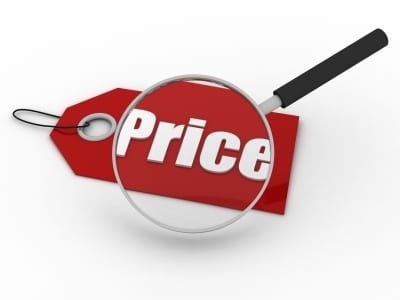Where to start and when to review…
Pricing your product or service is an extremely essential issue that every single business owner and sole trader must address. Get it right and you should find yourself dealing with happy customers. Get it wrong and you’ll either create the situation where you have too many customers and not enough money to cover the overhead or no customers at all.
Even if you have started up in business with the right pricing range set by customer feedback and you’re making a profit, this is something that needs to be monitored on a regular basis to keep up with consumer buying trends or changes in your product line. Even rise in fuel prices can trigger a change whereas a lowering in fuel might give you the extra cash flow to inject into a marketing offer. But if you don’t review and keep track of every aspect you are going to miss out on these opportunities.
When setting a price the best place to start is with your product or service. Remember that the overall aim is to make profit– either to reinvest, expand or take home. To do that you have to break down and cover you overheads. This costing must include everything for the creation of your product or service including a percentage for marketing, delivery charges, production costs, website maintenance, stationery, staffing, your time if necessary, and the list goes on and on…
If you’ve kept on top of things this shouldn’t take you too long. If you’ve employed someone to take care of your money as it’s not your strong point, then you need to ask them to help you break the costing down. It might make you more money savvy to do so which is always better in the long run.
With it all written down, double check to ensure it’s completely current. If you’re marketing a product needs to be divided by the exact amount that you can produce. It’s then a good idea to include an amount for contingency on top of this price to reflect any likely changes in your own market costs over the next six months.
This is your baseline costing. Look at this figure- does it look fair to you?
Then the ground work begins on actually setting a price. Some people add a simple 10% to their baseline costing, others 25% and it works for them. Calculate what it would be to do this and is it enough to achieve your initial profit relate goal? Will you sell enough at this price?
For others it is more a game of regarding their target market and seeing how their competitors place their pricing. Then this is where honesty comes in. Real harsh honesty.
What are you offering in comparison to your competitors?
Is your product or service better quality; is it organic, recyclable or Fair Trade made? Do you offer customer service and aftercare? All of these things are unique selling points, what makes you different from your competitors and the reason for why you can charge more or less than them in order to sell more.
All of these reasons are why you went into business- you honestly believed that you can offer something a little different to the norm and it needs to be priced accordingly.
If after looking at your costs you’ve settled on a price. Do you feel happy knowing your target market- will they be prepared and happy to part with their hard earned cash for it?
If your pricing is too high and you fear that no-one will pay that much for it, you still have a few options and Rick Stein the gourmet chef known in Paidstow, Cornwall for his Fish TV series turned this situation around to his advantage.
Rick recognised that a large percentage of his target market would not pay for his “a la carte” menu all year round. So to ensure sales he devised a scheme of owning four restaurants to fit all budgets and tastes from the top end cuisine right down to the fish and chip shop. The quality in all of them has his Rick Stein style but the pricing means that everyone can say that they’ve eaten his food. The humble chip once again wins as it brings him good custom and regular income from the masses.
Analyse your product again and see if there is a way that you can diversify like rick and offer different grades of service and product to fit consumer budgets.
When you are marketing high end goods, interestingly enough you will find that when the psychology of consumers is taken into account, most will save that little bit extra and pay more for that extra quality and assurance of good service, or for a rare or limited edition product.
Now you have a baseline price, you’ll want to maximise your sales so you need to write on a calendar your absolute key selling periods and your consumer buying times. This will help you implement marketing strategies that will work because they reflect your consumer’s needs. Any market fluctuations will be taken in your stride as you’ve left the room for them in your price leaving you confident that you can then do your job until the next scheduled price review.
It is very difficult to generalise on each product and service needs to be analysed specifically but with time and regular reviewing sessions of buying trends you will know your consumer’s mindset inside and out and will be able to adjust the price accordingly giving you the best start in business.


